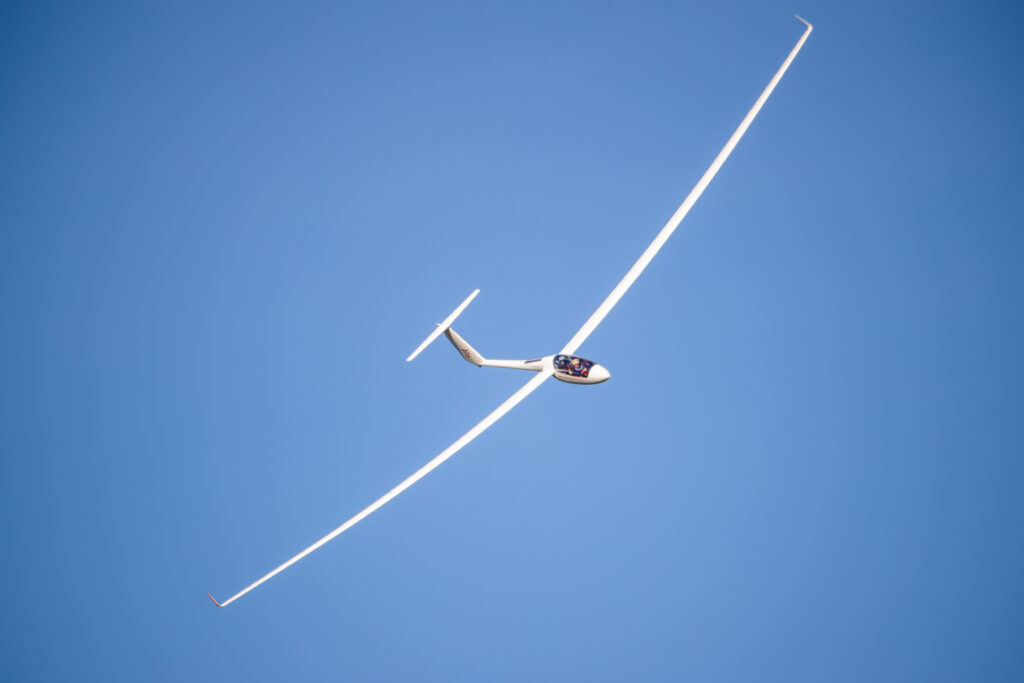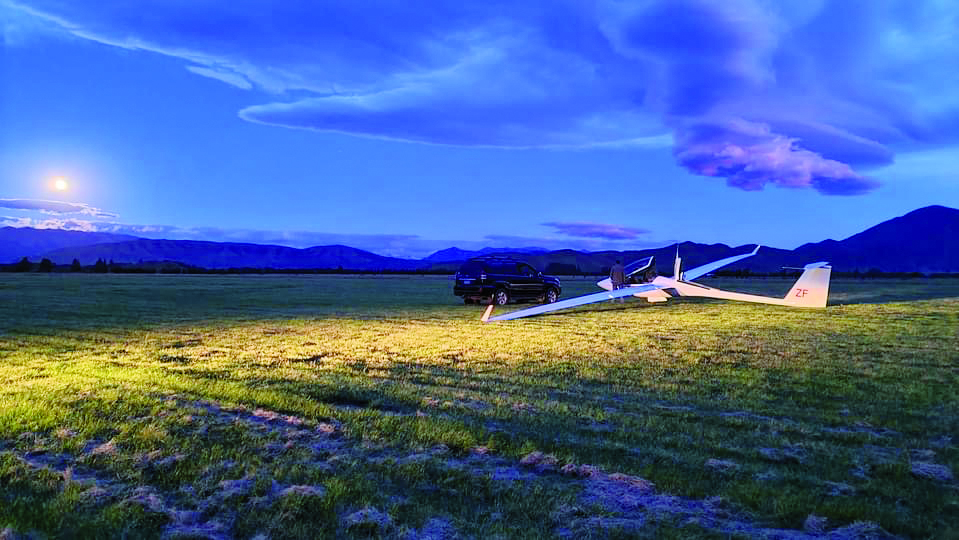By Abbey Delore
New Zealand’s dry nor-westers make for great soaring. For six summers my father, Terry Delore, and I watched weather patterns, seeking the perfect conditions to attempt to soar the length of the country, from Bluff to Cape Reinga.
With a few attempts under our belt, the logistical pre-take-off process had become streamlined and when the ideal day arrived, we were ready. It was 20 December 2021, and in less than 24 hours the nor-west airstream was inbound with an approaching southerly front.
Terry self-launched in GZF ASH-25mi from Canterbury Gliding Club, heading for Omarama, where I was managing logistics for the launch from our gliding base on the airfield. Oxygen systems for high altitudes, supplies for a long day in the cockpit, gear that looks more appropriate for a day’s skiing… all were packed into the limited space. By 8pm we were organised. Airways New Zealand had been notified of our proposed flight plan, and Terry headed to bed while I liaised with ground ops crew all over the country, getting set for grid at 4:45am, ready for launch at first light.
5:18am, Terry and I had parachutes on, toothbrushes packed and we self launched in GZF. We had wind on the ridge, a great sign, and climbed overhead Omarama as the sun rose. Established in weak wave, we headed south relatively slowly as the upper level wave system dumped on the lower level. A few hours in it was cranking and ZF was soaring at 26,000ft in -30oC temperature. We had the south coast and Stewart Island in sight.
8:27am and we reached Bluff. The plan from there was to soar north as far as we could, working with a tricky and dismantled wave run up the South Island. Rugged skies and reports of 100kt ground winds kept us well east of the Southern Alps, where clouds marked turbulent areas.

With high altitude mountain flying comes many complexities. One encountered was the batteries in the tail getting cold which causes them to drain. We chose to descend out of the upper level wave to warm the sailplane – and ourselves – aiming to conserve the batteries left. The entire flight ahead would be without electrics: old school soaring in silent flight so that we’d have essential power for the radio and transponder.
On up the South Island in multiple flight levels connecting and reconnecting with wave. Terry was primarily flying, while I was in the rear getting ATC clearances, navigating, seeking weather reports, webcams and communicating with our ground crew, scattered around the country. We swapped roles, sharing the flying, and collaborated throughout on reading the sky.
1:00pm and we were approaching Cook Strait. Reports were still blue skies further ahead, however we remained optimistic; the day was constantly improving. We approached the decision point of no return, and it was a green light for crossing Cook Strait – a barrier only a handful have soared across. Dad handed over controls and we were at 22,000ft, bound for the south coast of the North Island. Stopping midway to climb in wave, the excitement really kicked in.
ZF had a smooth crossing, reaching the North Island at 18,000ft, with two wave options in the offing. An excellent wave overhead Masterton gave us a great wave run up the middle of the Island, maintaining 19,000ft. Meanwhile our TrackMe tracker and midflight reports on our Delore Soaring Facebook page were gaining interest all over the world, capturing attention for our sport, and showcasing the performance and capabilities of these sailplanes.

Eleven hours on the trot, fueled by Pure Sports Nutrition electrolytes, we got the last squeeze of wave and veered towards Taupo. Removing some layers in the North Island heat, we cruised at optimal best glide, conserving height. A breeze coming off Lake Taupo was diminishing thermals, and we were steady on maximum glide as we passed Taupo Gliding Club at 9000ft.
4:50pm, we turned for our last weak thermal. By persevering and hopping from one thermal to the next, we got over the Kaimai Ranges. Gulps of relief, and ZF was in excellent ridge lift at 2500ft. For the next 100km we watched our shadow humming along the green native bush.
We’d been airborne for thirteen hours and it was getting late in the day as the lift began to fizz out. We jumped back on some weak convergence and a few thermals, pushing as close to Auckland Gliding Club in Drury as possible. Around 20km out we made the decision to use the motor to get altitude, allowing us to glide into a warm welcome at the Auckland Gliding Club.
Touch down: 14hrs, 7pm, 1600km or so. ZF had squeezed every inch out of the weather, light and sky to get there. Terry and I were chuffed: it had been a fantastic flight. The adventure was to be continued after Christmas, when another big challenge lay ahead.
11 January 2022: Auckland Gliding Club, Drury to the northern tip of New Zealand at Cape Reinga. Terry returned to Auckland a few days early, using pow- ered flight to scope out what lay ahead. The landscape in the north gets very low, the island shrinking in width with minimal land-out options; plenty of coastline, but retrieval headaches could be mammoth. We needed a great convergence day with colliding winds from both east and west. Terry collated information from local soar- ing pilots and, with encouragement from the Gliding NZ community, it was game on.
Terry had prepared GZF by the time I reached Auckland, flying commercially the night before our attempt.
11:40am, once the sky had established, we rolled down the runway and set GZF south, backtracking to the Bombay Hills where we’d left off. Patiently thermalling, we held altitude to where we could see cloud markers across the busy Auckland sector. One of the biggest challenges of the day was to soar across the Hauraki Gulf, at uncomfortably low level and in sync with Air Traffic Control so that we could remain clear of the region’s busy air traffic… Bingo! We had a 20 minute window: “Golf Zulu Foxtrot cleared to cross Auckland Sector, remaining above 2000ft.”

Hopping from thermal to thermal we maintained altitude clearance, ensuring we stayed a click ahead of recycling thermals to maximise every possible inch of lift. An hour later we were graced by an emerging convergence street that, once set up, proved to be a ripper. Gaining altitude, we cruised past the stunning coastline of Whangarei and the Bay of Islands. Our average ground speed was so good that our chase plane, carrying friends Al Kearney and Georgia Schoefield, were struggling to catch us.
2:30pm, the heavy showers forecast were visible. We decided to veer to the west coast and Ninety Mile Beach. We had 150km to soar but we were in unfamiliar territory with a low cloud base and rain showers threatening to shut us down. The landscape was dark, smoke from large wildfires, which had burned for weeks and were now smouldering, limiting visibility.
North of Kaitaia we got through a tense patch of air and were back in weak convergence. The chase plane caught up and flew ahead and lower to be our eyes. The distance clicked away: 100km, 80km, 70km to go. The island narrowed so that we had coastline off both left and right wingtips. GZF was getting near Cape Reinga. We called ahead: “Go ahead guys, we can see the lighthouse, we’re good.”
Hooking a weak thermal at 1800ft, a mere 700ft above the ground, we leapt over the tip of New Zealand. Cape Reinga. Terry and I had reached our goal, we were there! Georgia captured the moment at 4pm.
You’d think there would be a celebration in the cockpit, a sigh of relief: years of planning, preparation and energy had come to fruition. But returning to base was at the forefront of our mind.
We flew overhead a safe landout beach and raised the motor to get altitude on our side. ZF climbed to 6000ft and we continued the endurance flight southbound, reconnecting with convergence and soaring towards Auckland Gliding Club. Seven hours after take-off, we were back on the ground being handed champagne and Stella, celebrating with the gliding community and our team of supporters who had helped us achieve this unforgettable, first flight to have soared the length of New Zealand.
But ZF was still 1000km from home. The next day we soared south through the North Island in thermals and low level ridge lift, motored across Cook Strait and landed back in the South Island before a southerly front came through. Gliding friends, the Ackroyds, retrieved Terry and I for a wonderful layover in the Marlborough Sounds before the weather improved and we soared the final flight back to Springfield Aerodrome, Canterbury Gliding Club. A dream come true, soaring the length of New Zealand; one we could not have achieved without the fantastic support and encouragement of the Gliding New Zealand community.
This article first appeared in the Autumn 2023 edition of Approach Magazine, the dedicated magazine of AOPA NZ, which is published quarterly.

